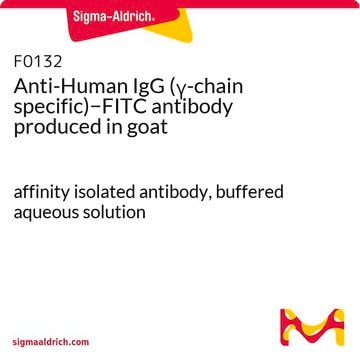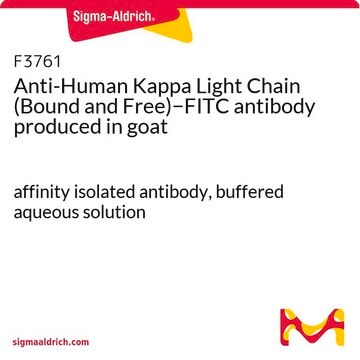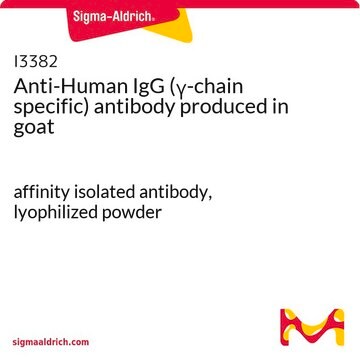F1641
Anti-Human IgG (γ-chain specific), F(ab′)2 fragment–FITC antibody produced in goat
affinity isolated antibody, buffered aqueous solution
Synonym(s):
Anti-Human IgG FITC
Sign Into View Organizational & Contract Pricing
All Photos(1)
About This Item
Recommended Products
biological source
goat
conjugate
FITC conjugate
antibody form
affinity isolated antibody
antibody product type
secondary antibodies
clone
polyclonal
form
buffered aqueous solution
technique(s)
direct immunofluorescence: 1:32
storage temp.
2-8°C
target post-translational modification
unmodified
General description
Human IgGs are glycoprotein antibodies that contain two equivalent light chains and a pair of identical heavy chains. IgGs have four distinct isoforms, ranging from IgG1 to IgG4. These antibodies regulate immunological responses to allergy and pathogenic infections. IgGs have also been implicated in complement fixation and autoimmune disorders
Anti-Human IgG (γ-chain specific), (F(ab′)2) fragment-FITC antibody is specific for human IgG when tested against purified human IgA, IgG, IgM, Bence Jones κ and λ myeloma proteins. The use of this product prevents background staining due to the presence of Fc receptors.
Anti-Human IgG (γ-chain specific), (F(ab′)2) fragment-FITC antibody is specific for human IgG when tested against purified human IgA, IgG, IgM, Bence Jones κ and λ myeloma proteins. The use of this product prevents background staining due to the presence of Fc receptors.
Immunoglobulin G (IgG) belongs to the immunoglobulin family and is a widely expressed serum antibody. The two heavy chains and two light chains of IgG are connected by a disulfide bond. It is a glycoprotein and mainly helps in immune defense. IgG is usually found as a monomer. IgG antibody subtype is the most abundant of serum immunoglobulins of the immune system. It is secreted by B cells and is found in blood and extracellular fluids. About 70 percent of the total immunoglobulin consists of IgG. Immunoglobulin G (IgG) participates in hypersensitivity type II and type III.
Immunogen
Purified human IgG
Application
Anti-Human IgG (γ-chain specific), (F(ab′)2) fragment-FITC antibody is suitable for use in direct immunofluorescence (1:32).
Anti-Human IgG (γ-chain specific), F(ab′)2 fragment−FITC antibody has been used in immunofluorescence studies and flow cytometric crossmatch (FCXM).
Physical form
Solution in 0.01 M phosphate buffered saline pH 7.4, containing 1% bovine serum albumin and 15 mM sodium azide
Disclaimer
Unless otherwise stated in our catalog or other company documentation accompanying the product(s), our products are intended for research use only and are not to be used for any other purpose, which includes but is not limited to, unauthorized commercial uses, in vitro diagnostic uses, ex vivo or in vivo therapeutic uses or any type of consumption or application to humans or animals.
Not finding the right product?
Try our Product Selector Tool.
Storage Class Code
12 - Non Combustible Liquids
WGK
nwg
Flash Point(F)
Not applicable
Flash Point(C)
Not applicable
Certificates of Analysis (COA)
Search for Certificates of Analysis (COA) by entering the products Lot/Batch Number. Lot and Batch Numbers can be found on a product’s label following the words ‘Lot’ or ‘Batch’.
Already Own This Product?
Find documentation for the products that you have recently purchased in the Document Library.
Customers Also Viewed
IgG
Encyclopedia of Immunology (1998)
Işın Sinem Bağcı et al.
Journal of biophotonics, 14(5), e202000509-e202000509 (2021-01-26)
Ex vivo confocal laser scanning microscopy (ex vivo CLSM) provides rapid, high-resolution imaging and immunofluorescence examinations of the excised tissues. We aimed to evaluate the applicability of ex vivo CLSM in histomorphological and direct immunofluorescence (DIF) examination of pemphigus vulgaris
Local activation of the complement system in endoneurial microvessels of diabetic neuropathy
Rosoklija G B, et al.
Acta Neuropathologica, 99(1), 55-62 (2000)
Işın Sinem Bağcı et al.
Experimental dermatology, 30(5), 684-690 (2020-12-22)
Ex vivo confocal laser scanning microscopy (CLSM) offers real-time examination of excised tissue in reflectance, fluorescence and digital haematoxylin-eosin (H&E)-like staining modes enabling application of fluorescent-labelled antibodies. We aimed to assess the diagnostic performance of ex vivo CLSM in identifying
I S Bağcı et al.
Journal of the European Academy of Dermatology and Venereology : JEADV, 33(11), 2123-2130 (2019-07-03)
Ex vivo confocal laser scanning microscopy (ex vivo CLSM) is a novel diagnostic method allowing rapid, high-resolution imaging of excised skin samples. Furthermore, fluorescent detection is possible using fluorescent-labelled antibodies. To assess the applicability of ex vivo CLSM in the
Our team of scientists has experience in all areas of research including Life Science, Material Science, Chemical Synthesis, Chromatography, Analytical and many others.
Contact Technical Service















